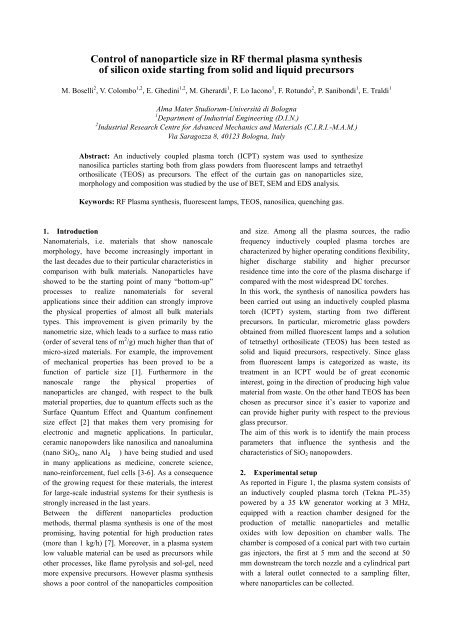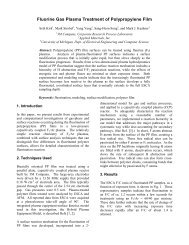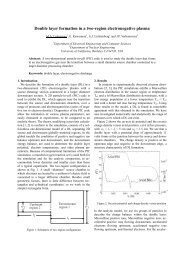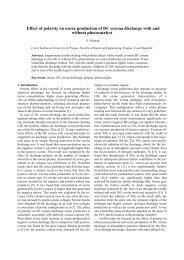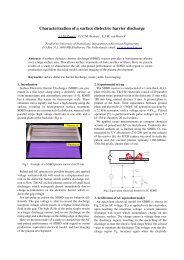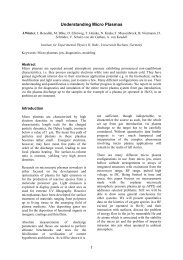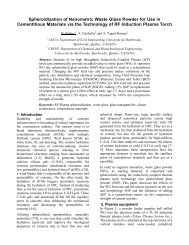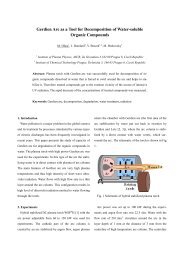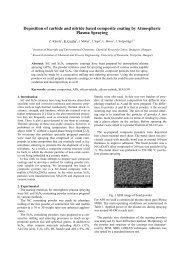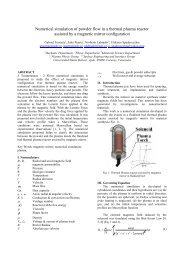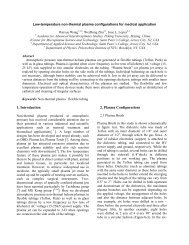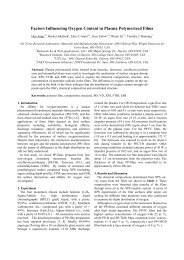Control of nanoparticle size in RF thermal plasma synthesis of ...
Control of nanoparticle size in RF thermal plasma synthesis of ...
Control of nanoparticle size in RF thermal plasma synthesis of ...
Create successful ePaper yourself
Turn your PDF publications into a flip-book with our unique Google optimized e-Paper software.
<strong>Control</strong> <strong>of</strong> <strong>nanoparticle</strong> <strong>size</strong> <strong>in</strong> <strong>RF</strong> <strong>thermal</strong> <strong>plasma</strong> <strong>synthesis</strong><strong>of</strong> silicon oxide start<strong>in</strong>g from solid and liquid precursorsM. Boselli 2 , V. Colombo 1,2 , E. Ghed<strong>in</strong>i 1,2 , M. Gherardi 1 , F. Lo Iacono 1 , F. Rotundo 2 , P. Sanibondi 1 , E. Traldi 1Alma Mater Studiorum-Università di Bologna1 Department <strong>of</strong> Industrial Eng<strong>in</strong>eer<strong>in</strong>g (D.I.N.)2 Industrial Research Centre for Advanced Mechanics and Materials (C.I.R.I.-M.A.M.)Via Saragozza 8, 40123 Bologna, ItalyAbstract: An <strong>in</strong>ductively coupled <strong>plasma</strong> torch (ICPT) system was used to synthe<strong>size</strong>nanosilica particles start<strong>in</strong>g both from glass powders from fluorescent lamps and tetraethylorthosilicate (TEOS) as precursors. The effect <strong>of</strong> the curta<strong>in</strong> gas on <strong>nanoparticle</strong>s <strong>size</strong>,morphology and composition was studied by the use <strong>of</strong> BET, SEM and EDS analysis.Keywords: <strong>RF</strong> Plasma <strong>synthesis</strong>, fluorescent lamps, TEOS, nanosilica, quench<strong>in</strong>g gas.1. IntroductionNanomaterials, i.e. materials that show nanoscalemorphology, have become <strong>in</strong>creas<strong>in</strong>gly important <strong>in</strong>the last decades due to their particular characteristics <strong>in</strong>comparison with bulk materials. Nanoparticles haveshowed to be the start<strong>in</strong>g po<strong>in</strong>t <strong>of</strong> many “bottom-up”processes to realize nanomaterials for severalapplications s<strong>in</strong>ce their addition can strongly improvethe physical properties <strong>of</strong> almost all bulk materialstypes. This improvement is given primarily by thenanometric <strong>size</strong>, which leads to a surface to mass ratio(order <strong>of</strong> several tens <strong>of</strong> m 2 /g) much higher than that <strong>of</strong>micro-<strong>size</strong>d materials. For example, the improvement<strong>of</strong> mechanical properties has been proved to be afunction <strong>of</strong> particle <strong>size</strong> [1]. Furthermore <strong>in</strong> thenanoscale range the physical properties <strong>of</strong><strong>nanoparticle</strong>s are changed, with respect to the bulkmaterial properties, due to quantum effects such as theSurface Quantum Effect and Quantum conf<strong>in</strong>ement<strong>size</strong> effect [2] that makes them very promis<strong>in</strong>g forelectronic and magnetic applications. In particular,ceramic nanopowders like nanosilica and nanoalum<strong>in</strong>a(nano SiO₂, nano Al₂ ) have be<strong>in</strong>g studied and used<strong>in</strong> many applications as medic<strong>in</strong>e, concrete science,nano-re<strong>in</strong>forcement, fuel cells [3-6]. As a consequence<strong>of</strong> the grow<strong>in</strong>g request for these materials, the <strong>in</strong>terestfor large-scale <strong>in</strong>dustrial systems for their <strong>synthesis</strong> isstrongly <strong>in</strong>creased <strong>in</strong> the last years.Between the different <strong>nanoparticle</strong>s productionmethods, <strong>thermal</strong> <strong>plasma</strong> <strong>synthesis</strong> is one <strong>of</strong> the mostpromis<strong>in</strong>g, hav<strong>in</strong>g potential for high production rates(more than 1 kg/h) [7]. Moreover, <strong>in</strong> a <strong>plasma</strong> systemlow valuable material can be used as precursors whileother processes, like flame pyrolysis and sol-gel, needmore expensive precursors. However <strong>plasma</strong> <strong>synthesis</strong>shows a poor control <strong>of</strong> the <strong>nanoparticle</strong>s compositionand <strong>size</strong>. Among all the <strong>plasma</strong> sources, the radi<strong>of</strong>requency <strong>in</strong>ductively coupled <strong>plasma</strong> torches arecharacterized by higher operat<strong>in</strong>g conditions flexibility,higher discharge stability and higher precursorresidence time <strong>in</strong>to the core <strong>of</strong> the <strong>plasma</strong> discharge ifcompared with the most widespread DC torches.In this work, the <strong>synthesis</strong> <strong>of</strong> nanosilica powders hasbeen carried out us<strong>in</strong>g an <strong>in</strong>ductively coupled <strong>plasma</strong>torch (ICPT) system, start<strong>in</strong>g from two differentprecursors. In particular, micrometric glass powdersobta<strong>in</strong>ed from milled fluorescent lamps and a solution<strong>of</strong> tetraethyl orthosilicate (TEOS) has been tested assolid and liquid precursors, respectively. S<strong>in</strong>ce glassfrom fluorescent lamps is categorized as waste, itstreatment <strong>in</strong> an ICPT would be <strong>of</strong> great economic<strong>in</strong>terest, go<strong>in</strong>g <strong>in</strong> the direction <strong>of</strong> produc<strong>in</strong>g high valuematerial from waste. On the other hand TEOS has beenchosen as precursor s<strong>in</strong>ce it’s easier to vaporize andcan provide higher purity with respect to the previousglass precursor.The aim <strong>of</strong> this work is to identify the ma<strong>in</strong> processparameters that <strong>in</strong>fluence the <strong>synthesis</strong> and thecharacteristics <strong>of</strong> SiO 2 nanopowders.2. Experimental setupAs reported <strong>in</strong> Figure 1, the <strong>plasma</strong> system consists <strong>of</strong>an <strong>in</strong>ductively coupled <strong>plasma</strong> torch (Tekna PL-35)powered by a 35 kW generator work<strong>in</strong>g at 3 MHz,equipped with a reaction chamber designed for theproduction <strong>of</strong> metallic <strong>nanoparticle</strong>s and metallicoxides with low deposition on chamber walls. Thechamber is composed <strong>of</strong> a conical part with two curta<strong>in</strong>gas <strong>in</strong>jectors, the first at 5 mm and the second at 50mm downstream the torch nozzle and a cyl<strong>in</strong>drical partwith a lateral outlet connected to a sampl<strong>in</strong>g filter,where <strong>nanoparticle</strong>s can be collected.
Table 1. Process parameters and filter yield for differenttests with solid precursor.Name <strong>of</strong>the test1A 2B 3A 4A 5A 6APrecursortypeA B A A A AUppercurta<strong>in</strong> gas 0 3 3 10 0 0(m³/h)Lowercurta<strong>in</strong> gas 0 0 0 0 0 12(m³/h)Feed rate(g/m<strong>in</strong>)6 6.5 2.3 1 N.A. N.A.Filter yield(g/h)N.A. 21 25 25 5 21N.A. = Not AvailableFigure 1. Schematic <strong>of</strong> the <strong>plasma</strong> <strong>nanoparticle</strong>s <strong>synthesis</strong>system.A Tekna Plasma Systems powder feeder PF400 hasbeen used for the <strong>synthesis</strong> <strong>of</strong> silica nanopowdersstart<strong>in</strong>g from a solid glass precursor, <strong>in</strong>ject<strong>in</strong>g powders<strong>in</strong> the <strong>plasma</strong> torch trough an <strong>in</strong>jection probe. Anelectrical oven has been used to pre-heat precursorsbefore <strong>in</strong>jection.A Tekna Plasma Systems suspension feeder SF-300has been used for the liquid precursor <strong>in</strong>jection us<strong>in</strong>gan atomization probe send<strong>in</strong>g atomized precursordroplets <strong>in</strong> the core <strong>of</strong> the <strong>plasma</strong> discharge by means<strong>of</strong> a carrier gas (Ar).3. Nanoparticle and precursor characterizationSize, morphology and composition <strong>of</strong> synthetizedpowders have been analysed. Specific surface area(SSA) analysis was carried out us<strong>in</strong>g a NOVA 2200eanalyser (Quantachrome Instruments), based on BETtheory [8]. Before nitrogen adsorption, samples weredried at 300°C and degassed. A mean diameter <strong>of</strong><strong>nanoparticle</strong>s can be evaluated specific surface areaassum<strong>in</strong>g spherical and dense particles and us<strong>in</strong>g thefollow<strong>in</strong>g relation:where D is the mean diameter and ρ is the density(≈2300 kg/m³ for the glass <strong>of</strong> fluorescent lamps, ≈2650kg/m³ for pure silica). A scann<strong>in</strong>g electron microscope(EVO 50 from ZEISS) was used to study the <strong>size</strong> andmorphology <strong>of</strong> precursor particles and <strong>of</strong> the produced<strong>nanoparticle</strong>s; analysis <strong>of</strong> the chemical composition <strong>of</strong>the particles was carried out us<strong>in</strong>g Energy-DispersiveX-ray Spectroscopy (EDS).(1)4. Nanosilica <strong>synthesis</strong> from solid precursorsMicrometric glass powders used as precursor wereobta<strong>in</strong>ed from gr<strong>in</strong>ded fluorescent lamps with differentmeshes (average diameter: precursor A = 38-75 μmprecursor B = 75-125 μm). The mercury content hasbeen removed from the glass powders before the<strong>plasma</strong> treatment, for safety reasons. EDS analysis <strong>of</strong>powders showed that they are ma<strong>in</strong>ly composed bySiO₂ and Na₂O with small fraction <strong>of</strong> other elements asmetallic oxides (O 52.40%, Na 10.87%, Mg 1.50%, Al1.14%, Si 30.19%, K 0.90%, Ca 2.99% by weight, withonly slight variations <strong>in</strong> different samples). Thesamples were heated at a temperature <strong>of</strong> 180°C for onehour <strong>in</strong> an oven to <strong>in</strong>crease the powder flowabilitydur<strong>in</strong>g <strong>in</strong>jection. Different tests for the production <strong>of</strong>silica <strong>nanoparticle</strong>s have been performed keep<strong>in</strong>g fixed<strong>plasma</strong> operat<strong>in</strong>g conditions and chang<strong>in</strong>g the curta<strong>in</strong>gas flow conditions, precursor feed rate and precursortype, as reported <strong>in</strong> Table 1. As a comparison betweendifferent tests, the amount <strong>of</strong> <strong>nanoparticle</strong>s collected <strong>in</strong>the sampl<strong>in</strong>g filter has been measured and normalizedwith respect to the duration <strong>of</strong> the test, thus obta<strong>in</strong><strong>in</strong>g amean collection rate <strong>in</strong> the sampl<strong>in</strong>g filter that will becalled “filter yield” <strong>in</strong> the next sections. Argon hasbeen used as carrier gas and <strong>plasma</strong> gas with a flowrate <strong>of</strong> 6 slpm and 13 slpm, respectively. Air was usedfor sheath gas, <strong>in</strong>jected with a flow rate <strong>of</strong> 60 slpm. Airhas also been used as curta<strong>in</strong> gas <strong>in</strong> the reactionchamber, with conditions reported <strong>in</strong> Table 1. Totalpower <strong>of</strong> the <strong>RF</strong> system was set to 30 kW and thereaction chamber operat<strong>in</strong>g pressure was set to 70 kPa.Only one test has been done with precursor B s<strong>in</strong>ce itslow vaporization efficiency <strong>in</strong>duced the formation <strong>of</strong>millimetric SiO₂ crystals <strong>in</strong> the chamber and near thetorch outlet.Tests with precursor A have been carried out fordifferent conditions <strong>of</strong> the curta<strong>in</strong> gas. As can be seen<strong>in</strong> Table 1 compar<strong>in</strong>g test 5A with other ones, an
Table 2. Results <strong>of</strong> BET analysisName <strong>of</strong>the testSpecific SurfaceArea (m 2 /g)Mean Diameter(nm)1A 9.4 2782B 17.8 1463A 18.6 140Table 3. Composition (w%) <strong>of</strong> samples collected <strong>in</strong> the filterTest O Na Mg Al Si K Ca2B 51 22 0 0.6 24.2 1.4 0.63A 51 18 0.6 0 27.9 1.2 0.7Table 4. Operat<strong>in</strong>g parameters for different tests with liquidprecursorTestSheath Gas(slpm)Curta<strong>in</strong> Gas(m 3 /h)Feed rate(g/m<strong>in</strong>)T1 60 air 6 U/D 2.5T2 60 air 3 U/D 2.5T3 60 air 6 U/D 5Figure 2. SEM image <strong>of</strong> nanosilica powders synthe<strong>size</strong>d <strong>in</strong>test 3AFigure 3. Crystall<strong>in</strong>e particle <strong>in</strong> the sample <strong>of</strong> test 3A<strong>in</strong>crease <strong>in</strong> curta<strong>in</strong> gas flow rate results <strong>in</strong> a higheramount <strong>of</strong> powders collected <strong>in</strong> the filter per unit time.High precursor feed rates don’t ensure greatimprovements on filter yield (test 2B and 3A) Nosignificant variation <strong>of</strong> filter yield has been obta<strong>in</strong>ed<strong>in</strong>creas<strong>in</strong>g the upper curta<strong>in</strong> gas flow rate from 3 to 10m 3 /h while reduc<strong>in</strong>g the precursor feed rate from 2.3 to1 g/m<strong>in</strong> (tests 3A and 4A). The use <strong>of</strong> the lower curta<strong>in</strong>gas <strong>in</strong>let is less effective than the upper one, as shownfrom filter yield obta<strong>in</strong>ed <strong>in</strong> tests 4A and 6A. Resultsfrom specific surface area (SSA) analysis and thecorrespond<strong>in</strong>g mean diameter have been reported <strong>in</strong>Table 2. The use <strong>of</strong> curta<strong>in</strong> gas <strong>in</strong>duces an <strong>in</strong>crease <strong>of</strong>SSA and a reduction <strong>of</strong> the mean diameter <strong>of</strong> particlescollected <strong>in</strong> the sampl<strong>in</strong>g filter (see Table 2).SEM images <strong>of</strong> the test 3A are reported <strong>in</strong> Figure 2 and3, respectively. Though most <strong>of</strong> the particles werespheroidized and nanometric, even with diametersmaller than 40 nm (Figure 2), some crystall<strong>in</strong>eparticles reached the filter (Figure 3). These crystall<strong>in</strong>eparticles are micrometric and they reduce the value <strong>of</strong>the specific surface area. Their presence could be theeffect <strong>of</strong> a not completed vaporization <strong>of</strong> the precursor<strong>in</strong> the <strong>plasma</strong> torch. An excess or an <strong>in</strong>homogeneousfeed rate could be the reasons lead<strong>in</strong>g to unevaporatedprecursor. The EDS analysis <strong>of</strong> samples collected <strong>in</strong>the filter from tests 2B and 3A (see Table 3) shows thedecrease <strong>of</strong> Si weight fraction and the <strong>in</strong>crease <strong>of</strong> Naand K after <strong>plasma</strong> treatment. The different boil<strong>in</strong>gpo<strong>in</strong>ts <strong>of</strong> Na and Si oxides (1950°C and 2230°Crespectively) lead to an easier nucleation <strong>of</strong> Na₂O<strong>nanoparticle</strong>s, penaliz<strong>in</strong>g the formation <strong>of</strong> SiO₂ andthen the quality <strong>of</strong> the f<strong>in</strong>al product. Also the presence<strong>of</strong> N₂ may lead to this effect, reduc<strong>in</strong>g the partialpressure <strong>of</strong> gaseous SiO and the nucleation <strong>of</strong> nanoSiO 2 [9].5. Nanosilica <strong>synthesis</strong> from liquid precursorSynthesis tests have been carried out with liquidprecursor. The <strong>in</strong>fluence on the process <strong>of</strong> the liquidfeed<strong>in</strong>g rate (regulated directly on the suspensionfeeder) and <strong>of</strong> the curta<strong>in</strong> gas (<strong>in</strong>jected from twopositions <strong>in</strong> the reaction chamber) has been evaluated.Process parameters for different tests have beenreported <strong>in</strong> Table 4, whereas results for filter yield andspecific surface area are shown <strong>in</strong> Table 5. An <strong>in</strong>crease<strong>of</strong> the process yield can be observed for the cases withhigher <strong>in</strong>jection <strong>of</strong> curta<strong>in</strong> gas (cases T1 and T3). CaseT1 reaches 130% <strong>of</strong> improvement <strong>of</strong> filter yield withrespect to case T2. As can be seen <strong>in</strong> Table 5,synthetized powders collected <strong>in</strong> the filter have a lowerdiameter with respect to that <strong>of</strong> powders obta<strong>in</strong>ed withsolid precursors, with BET values <strong>of</strong> 70-90 m 2 /g.
Table 5. Results <strong>of</strong> tests with liquid precursorTest Filteryield (g/h)SSA(m 2 /g)Meandiameter(nm)T1 3.8 90 29T2 1.44 70 37T3 3.89 60 43Figure 4. SEM image <strong>of</strong> nanosilica powders from filterTable 6. Composition (w%) <strong>of</strong> samples collected <strong>in</strong> the filterTest C O Si AuT2 5.35 50.96 35.32 8.36T3 3.74 48.95 37.78 9.52In Figure 4, a SEM picture shows that all particlescollected are nanometric and that they show a tendencyto form agglomerates. It can be noticed from EDS thata higher purity <strong>of</strong> product can be obta<strong>in</strong>ed from TEOSwith respect to that <strong>of</strong> powders obta<strong>in</strong>ed from solidprecursors (see Table 6). Comparison <strong>of</strong> results <strong>of</strong> testT1 and test T3 (see Table 5) show that <strong>in</strong>creas<strong>in</strong>g thefeed rate the filter yield slightly changes and sampled<strong>nanoparticle</strong>s are characterized by slightly lower SSA.6. ConclusionResults show that the ratio between the filter yield andthe precursor feed rate is higher for solid than for liquidprecursors. However, non-vaporized precursor powdershave been collected <strong>in</strong> the filter <strong>in</strong> case <strong>of</strong> solidprecursor, whereas with liquid precursor only nano<strong>size</strong>dparticles have been obta<strong>in</strong>ed. Furthersimulative/experimental studies will be conducted todeterm<strong>in</strong>e operat<strong>in</strong>g conditions for the silica <strong>synthesis</strong>process that guarantee optimal evaporation rate <strong>of</strong> solidprecursors as dependent from their dimension and massflow rate, also tak<strong>in</strong>g <strong>in</strong>to account load<strong>in</strong>g effects.Moreover, it has been shown that the use <strong>of</strong> curta<strong>in</strong>gases generally gives the possibility to collect a higheramount <strong>of</strong> powders <strong>in</strong> the filter and at the same timeleads to a reduction <strong>of</strong> their mean diameters.To better understand the effects <strong>of</strong> the curta<strong>in</strong> gasescomposition on the chemical-physical process <strong>of</strong>nanosilica <strong>synthesis</strong> further studies on the use <strong>of</strong> aquench<strong>in</strong>g gas need to be conducted.References[1] S. Y. Fu, X. Q. Feng, B. Lauke, Y. W. Mai, Effects<strong>of</strong> particle <strong>size</strong>, particle/matrix <strong>in</strong>terface adhesion andparticle load<strong>in</strong>g on mechanical properties <strong>of</strong>particulate–polymer composites, Composites: Part B39 (2008) 933-961.[2] J. A. Smyder, T. D. Krauss, Com<strong>in</strong>g attractions forsemiconductor quantum dots, Materials Today 14(2011) 382-396.[3] T. K. Barik, B. Sahu, V. Swa<strong>in</strong>, Nanosilica frommedic<strong>in</strong>e to pest control, Parasitology Research 103(2008) 253-258.[4] B. W. Jo, C. H. Kim, G. H. Tae, J. B. Park,Characteristics <strong>of</strong> cement mortar with nano-SiO2particles, Construction and Build<strong>in</strong>g Materials 21(2007) 1351-1355.[5] C. Borgonovo, D. Apelian, Manufacture <strong>of</strong>Alum<strong>in</strong>um Nanocomposites: A Critical Review,Advances <strong>in</strong> Metal Matrix Composites - MaterialsScience Forum 678 (2011) 1-22.[6] D. Kim, M. A. Scibioh, S. Kwak, I. H. Oh, H. Y.Ha, Nano-silica layered composite membranesprepared by PECVD for direct methanol fuel cells,Electrochemistry Communications 6 (2004) 1069-1074.[7] D. Vollath, Plasma <strong>synthesis</strong> <strong>of</strong> nanopowders,Journal <strong>of</strong> Nanoparticle Research 10 (2008) 39-57.[8] S. Brunauer, P. H. Emmett, E. Teller, Adsorption<strong>of</strong> Gases <strong>in</strong> Multimolecular Layers, Journal <strong>of</strong> theAmerican Chemical Society 60 (1938) 309-319.[9] D. Harbec, F. Gitzh<strong>of</strong>er, A. Tagnit-Hamou,Induction <strong>plasma</strong> <strong>synthesis</strong> <strong>of</strong> nanometric spheroidizedglass powder for use <strong>in</strong> cementitious materials, PowderTechnology 214 (2011) 356-364.


